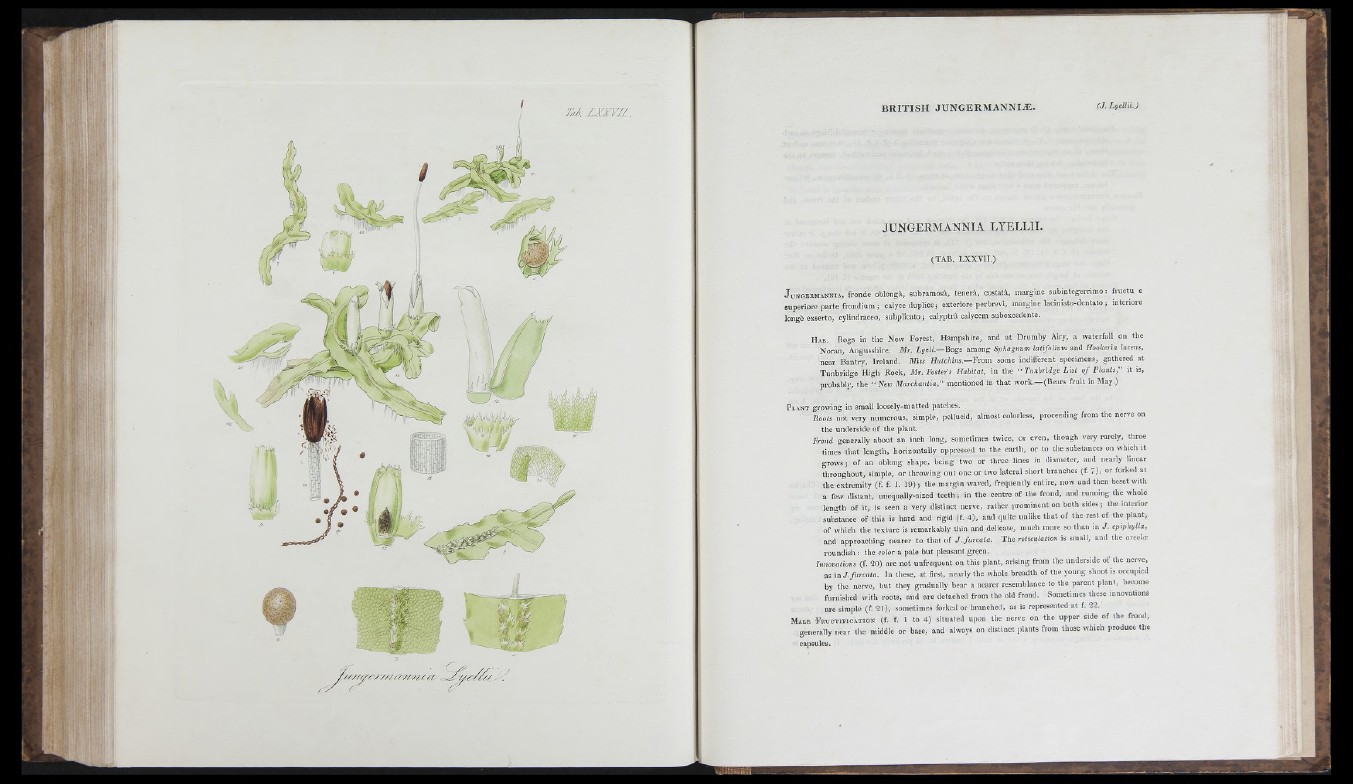
••J .
f f '
' . l i
: i-i'
■ ,
■' . ' i i
1 . 8
■!■ i; ■
-i ■
:: !
y / / z 7 Y Y r /A a
JU N G E RM A N N IA L Y E L L II.
(TAB. LX X V II,)
J u n g e rm a n n ia , f ro n d e o b lo n g à , s u b r am o s â , te n e r a , c o s ta tâ , m a rg in e s u b in t e g e r r im o : f r u c tu e
s u p e r io r e p a r t e f ro n d ium ; c a ly c e d u p lic e ; e x te r io r e p e rb r e v i , m a rg in e la e in ia to - d e n ta to ; in te r io re
lo n g è e x s e r to , c y lin d ra c e o , s u b p li c a to ; c a ly p tr à c a ly c em su b e x c e d e n te .
H ab. Bogs in tlie New Fore st, Hampshire, and a t Driimby Airy, a waterfall o n the
Noran, Angusshire. Mr. L y e li— Bogs among Sphagnum latifolium and Hookeria lucens,
ne a r Bantry, Ireland. Miss Hutchins.— From some indifferent specimens, gathered at
T u nbridge High Rock, Mr. Foster’s Habitat, in the “ Tunbridge L is t o f Plants,'' it is,
probably, th e “ New Marchantia,” mentioned in th a t work.— (Bears f ru it in May.)
P la n t g r o w in g in sm a ll lo o s e ly -m a t te d p a tc h e s .
Rools n ot very numerous, simple, pelluciil, almost colorless, proceeclliig from the nerve on
th e underside o f the jdant.
Frond generally about an inch long, sometimes twice, o r even, though very rarely, three
times (h a t len g th , horizontally appressed to th e e a rth , or to the s
grows ; of an oblong shape, being two o r th re e lines
thro u g h o u t, simple, o r throwing o ut one c
iubstances on which it
I diameter, and nearly linear
r two la te ra l sh o rt branches (f- 7 ) , o r forked at
th e extrem ity (f. f. 1. 19) ; the ma rgin waved, frequently entire , now and then beset w ith
a few distant, unequally-sized teeth ; in th e centre o f th e frond, and ru nning the whole
len g th o f it, is seen a very distinct nerve, ra th e r prominent on both side s; the interior
substance o f this is ha rd and rigid (f. 4 ), and quite unlike th a t o f th e re st of the p lan t,
of which th e tex tu re is remarkably iliin and delicate, much more so than in J . epiphylla,
and approaching nearer to th a t o f J .fu r c a ta . The reticulation is small, and the areolæ
roundish : the color a pale b ut pleasant green.
Innovations (f. SO) are n ot unfrequent on this plant, arising from the underside o f the nerve,
as in J .fu r ca ta . In these, a t first, nearly th e whole breadth o f th e young shoot is occupied
by th e nerve, b ut they gradually bear a nearer resemblance to the pa rent p lant, become
furnished with roots, and a re dc’lached from the old frond. Sometimes these innovations
arc simple (f. 2 1 ) , sometimes forked or branched, as is represented a t f. 22.
M ale F r u c t i f i c a t i o n ( f. f. 1 to 4 ) s itu a te d u p o n th e n e rv e o n th e u p p e r s id e o f (h e f ro n d ,
g e n e r a lly n e a r th e m id d le o r b a se , a n d a lw ay s o n d i s t in c t p la n ts f rom th o s e w h ic h p r o d u c e th e
c a p su le s .
' I